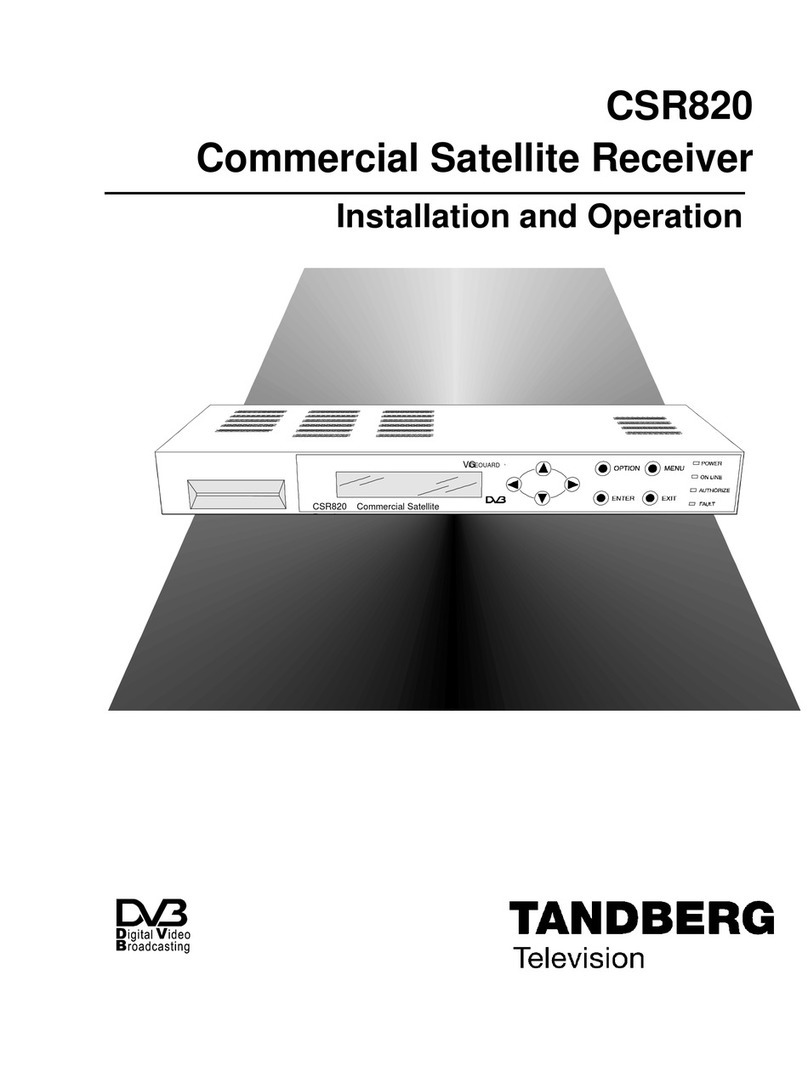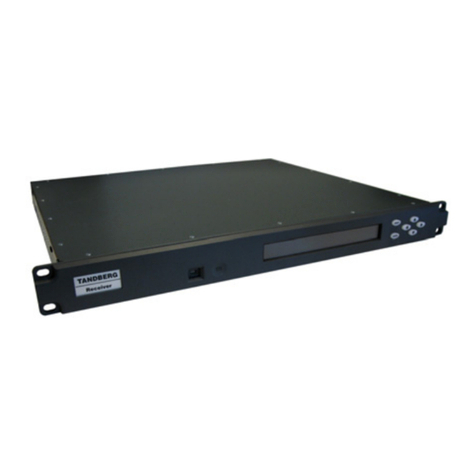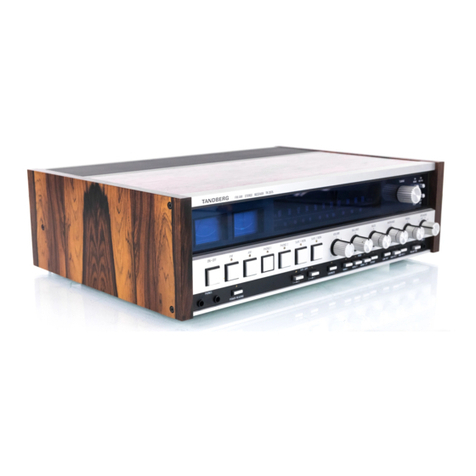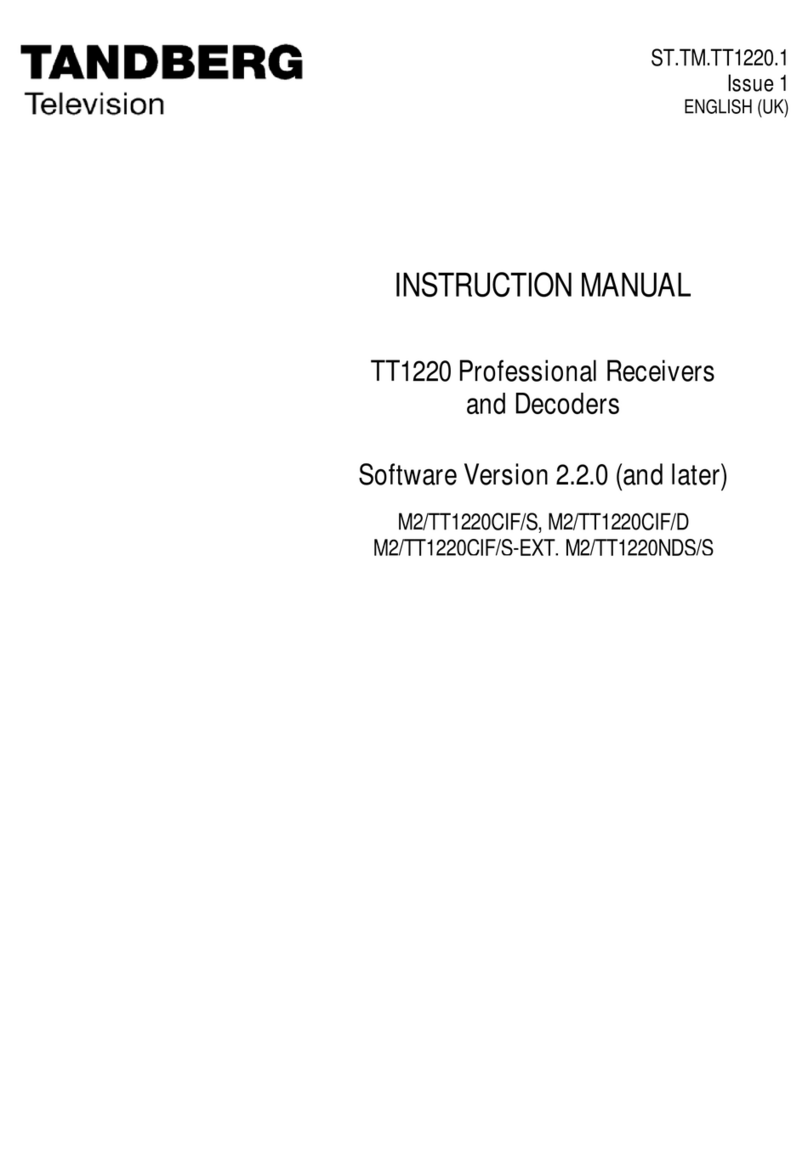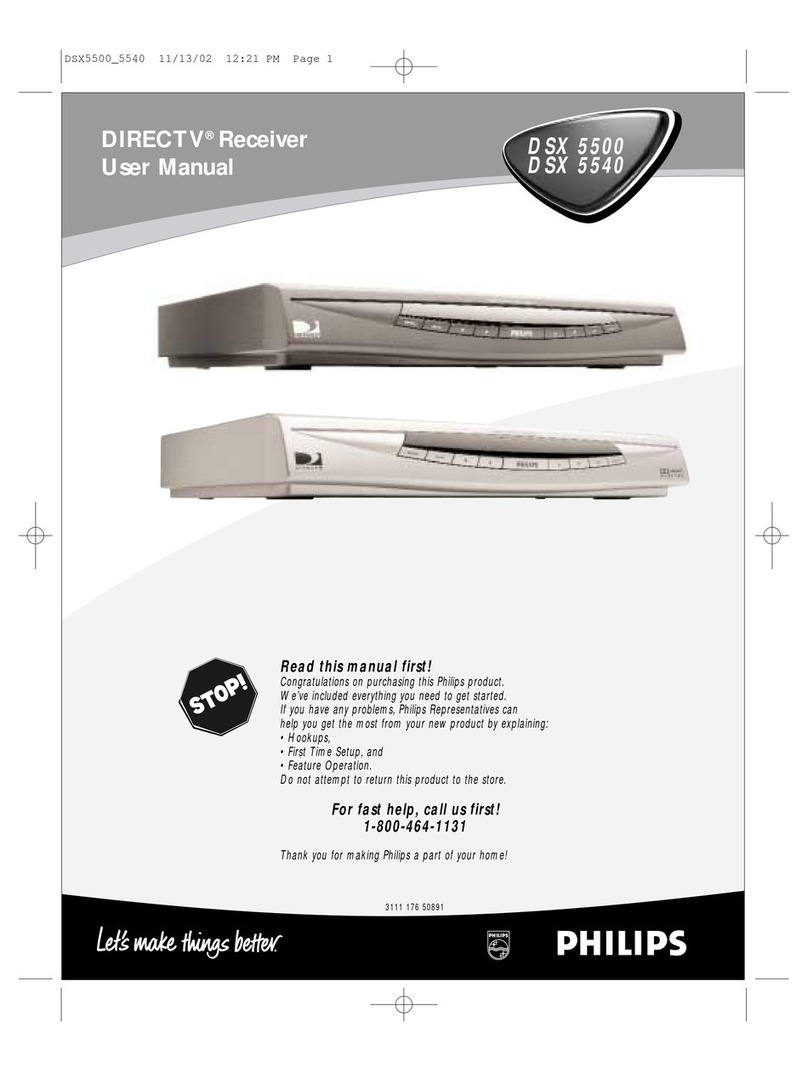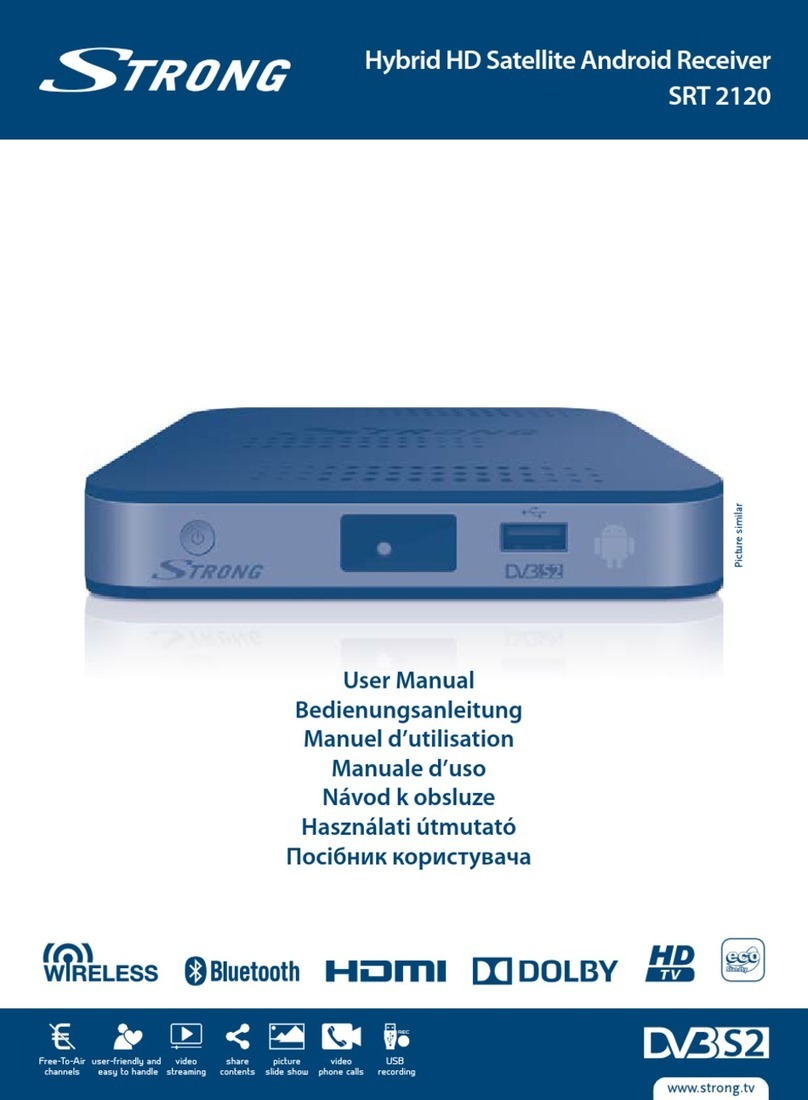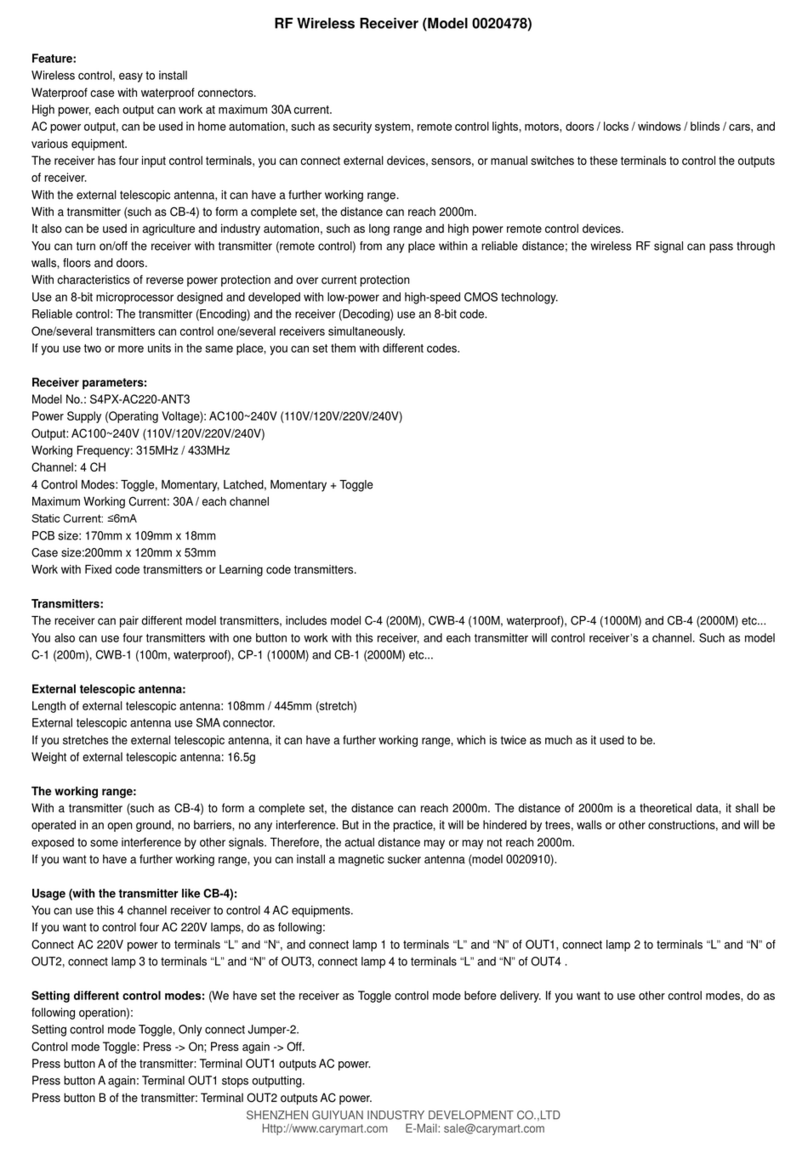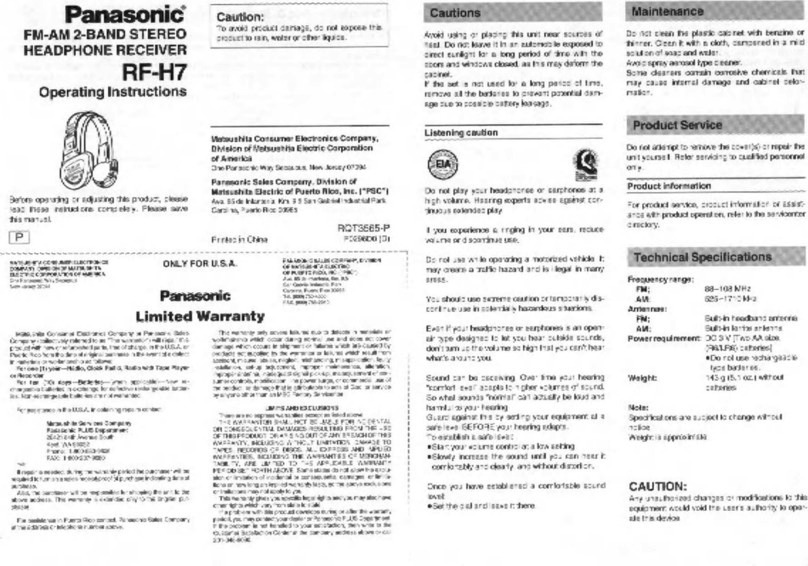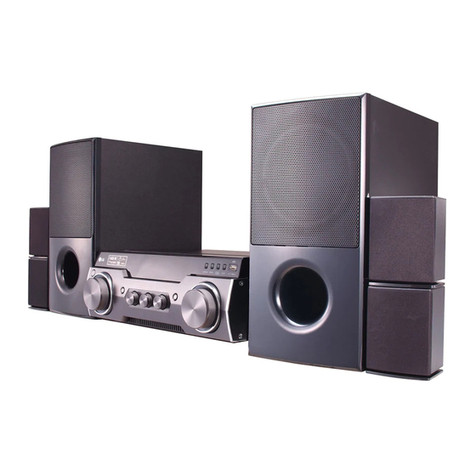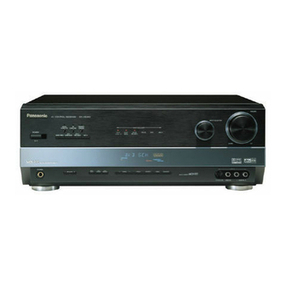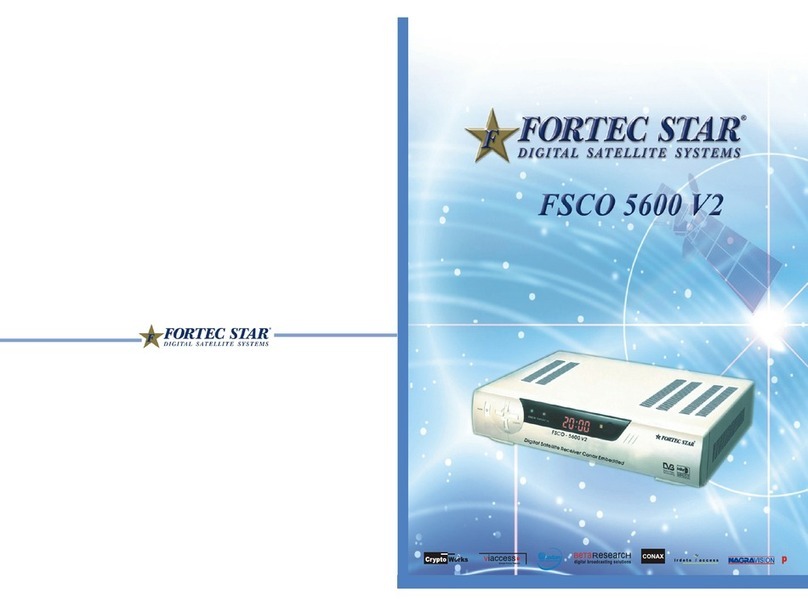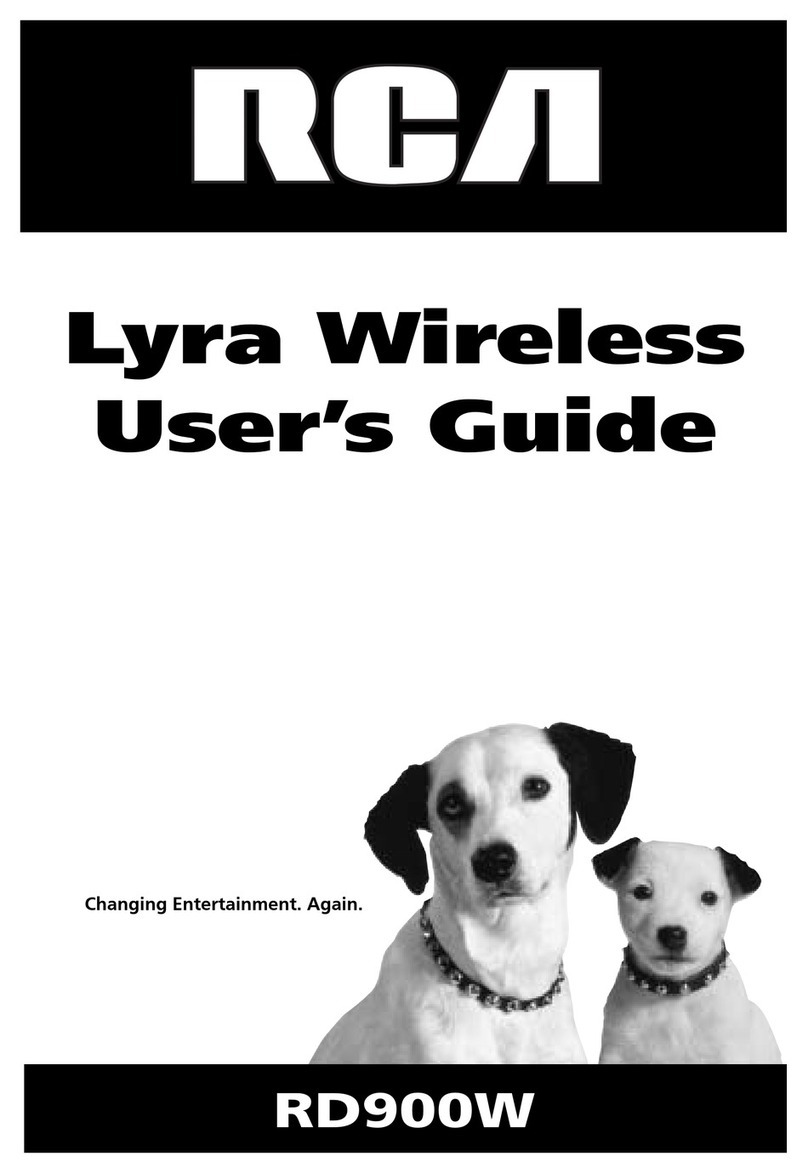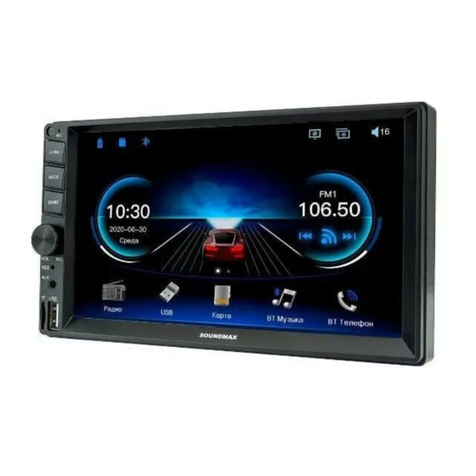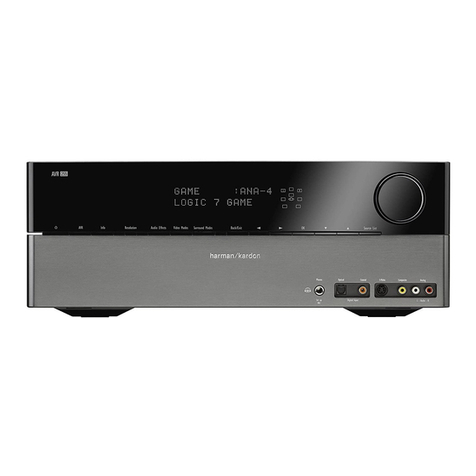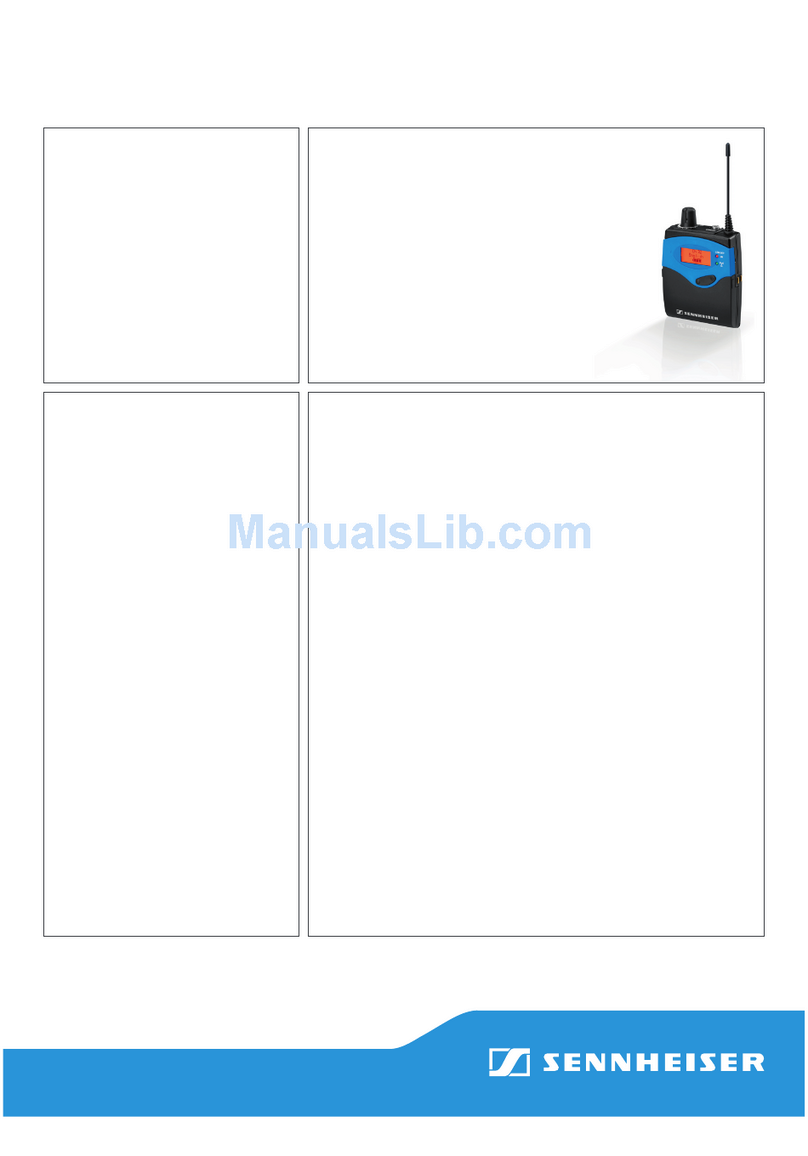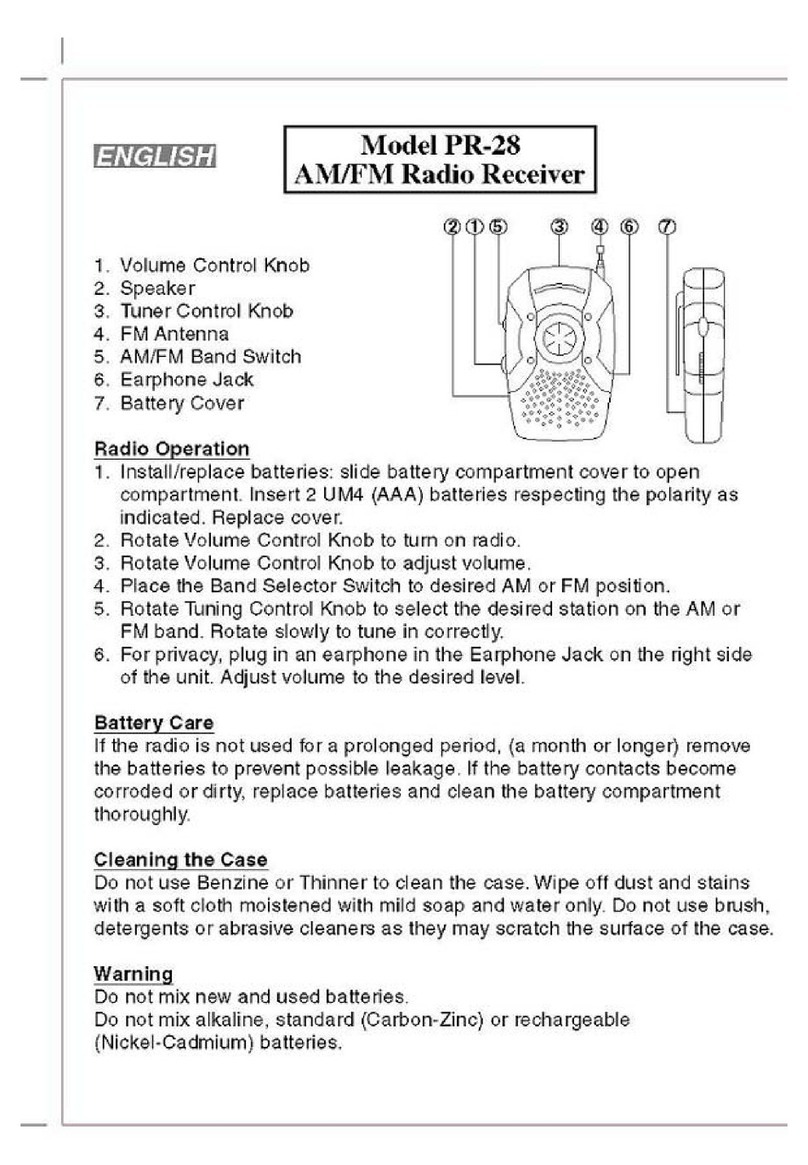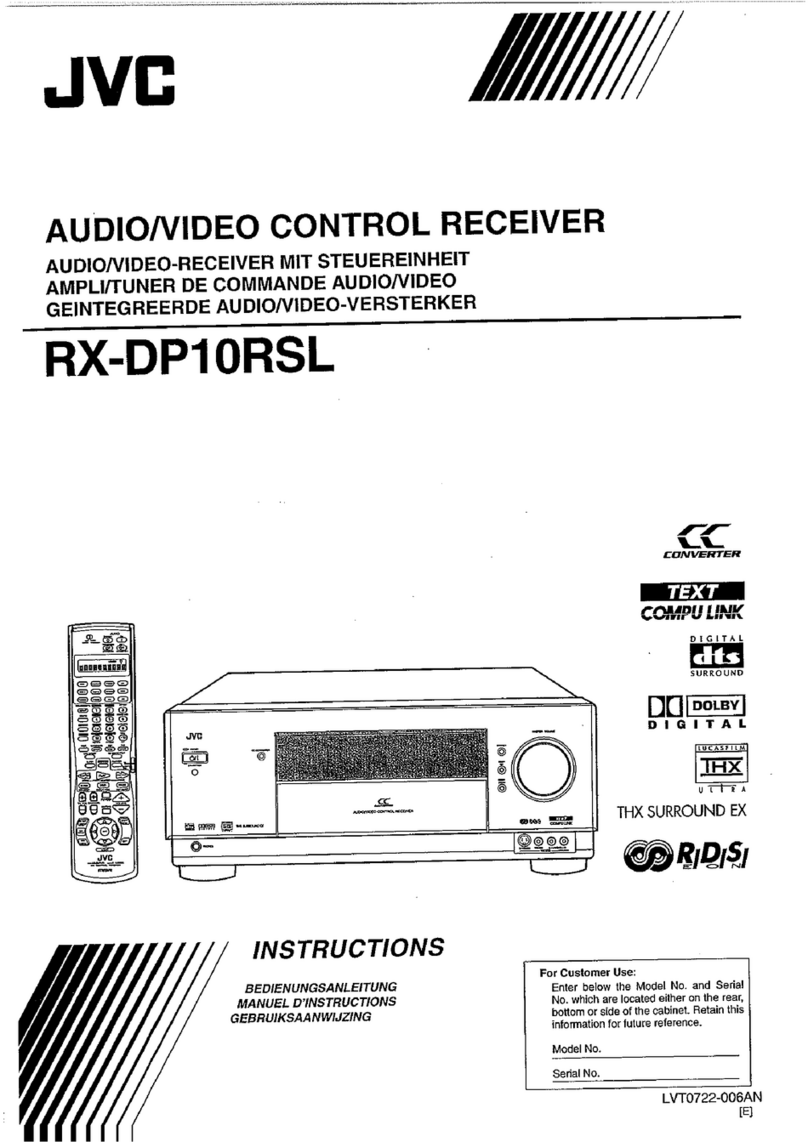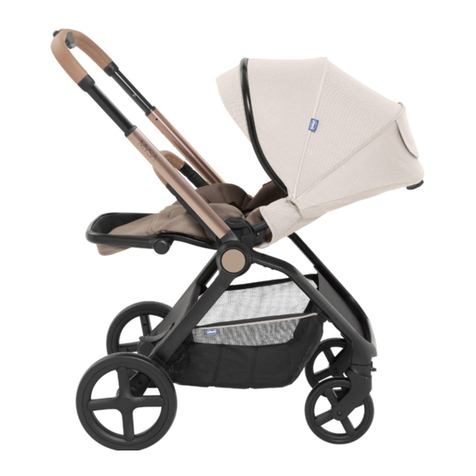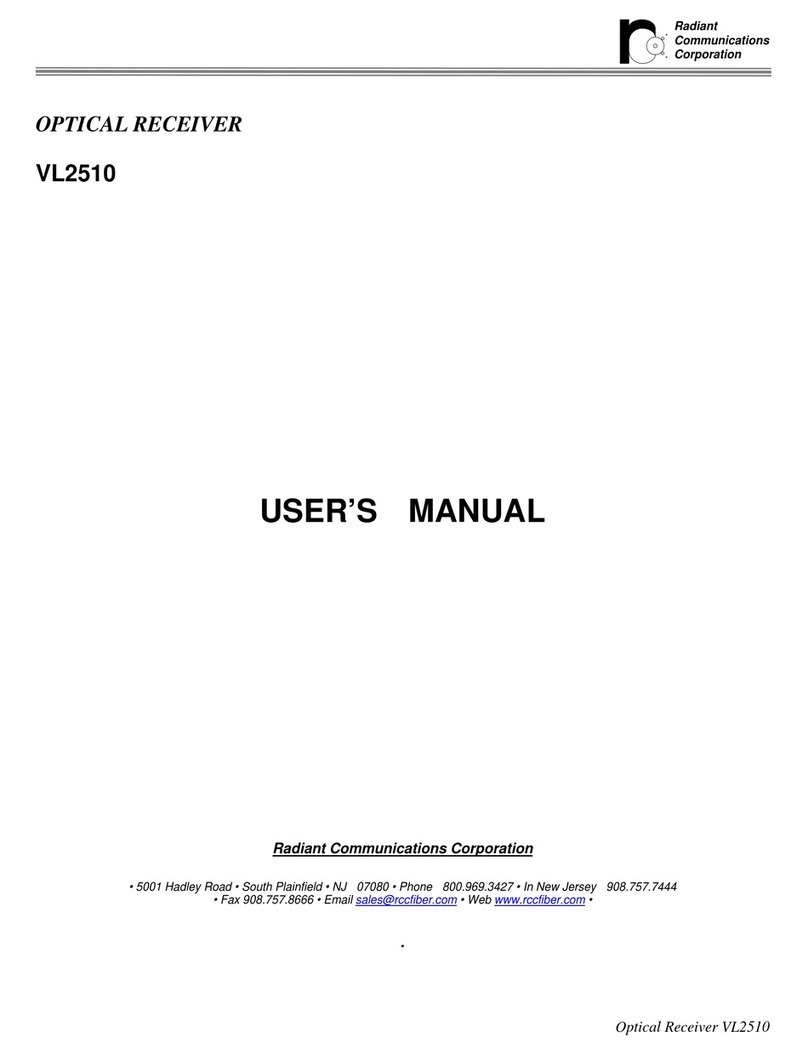TANDBERG Alteia User manual

ST.TM.E9200.8
Issue 8
ENGLISH (UK)
INSTRUCTION MANUAL
Alteia and Alteia plus
Professional Receivers and Decoders
Software Version 2.1 (and later)
[Demultiplexer App Code Version]
M2/PDU/942, M2/P8R/942, M2/PSR/932,
M2/PSR/942, M2/PTR/94x, M2/PTRE/94x
and Options
Typical Alteia plus Satellite Receiver

Preliminary Pages
Page ii Instruction Manual: Alteia and Alteia plus Professional Receivers and Decoders
ST.TM.E9200.8
Issue 8 first published in 2002 by:
TANDBERG TELEVISION LTD
REGISTERED ADDRESS:
UNIT 2 STRATEGIC PARK, COMINES WAY,
HEDGE END, SOUTHAMPTON,
HAMPSHIRE, SO30 4DA
UNITED KINGDOM
Registered Company Number 03695535
This document and the information contained in it is the property o
f
TANDBERG Television Ltd and may be the subject of patents
pending and granted. It must not be used for commercial purposes
nor copied, disclosed, reproduced, stored in a retrieval system or
transmitted in any form or by any means (electronic, mechanical,
photocopying, recording or otherwise), whether in whole or in part,
without TANDBERG Television’s prior written agreement.
Ó1998 – 2002 TANDBERG Television Ltd. All rights reserved.
SVENSKA
LÄS DETTA FÖRST!
Om Ni inte förstår informationen i denna handbok
ARBETA DÅ INTE MED DENNA UTRUSTNING.
En översättning till detta språk av denna handbok kan också anskaffas, på
Er bekostnad.
ENGLISH (UK)
READ THIS FIRST!
If you do not understand the contents of this manual
DO NOT OPERATE THIS EQUIPMENT.
Also, translation into any EC official language of this manual can be made
available, at your cost.
ΕΛΛΗΝΙΚΑ
ÄΙΑΒΑΣΤΕ ΠΡÙΤΑ ΑΥΤΟ!
Αν δεν καταλÜβετε το περιεχüìενο αυτοý του βοηθÞìατοò/εγχειριδßου
ΜΗΝ ΛΕΙΤΟΥΡΓΗΣΕΤΕ ΑΥΤΟΝ ΤΟΝ ΕΞΟΠΛΙΣΜΟ.
Επßσηò, αυτü το εγχειρßδιο εßναι διαθÝσιìοσε ìετÜφραση
σε αυτÞ τη γλþσσα και ìπορεßτε να το αγορÜσετε.
DEUTSCH
LESEN SIE ZUERST DIESEN HINWEIS!
Sollte Ihnen der Inhalf dieses Handbuches nicht klar verständlich sein,
dann
BEDIENEN SIE DIESE GERÄTE NICHT!
Eine Übersetzung des Handbuches in diese Sprache ist gegen
Berechnung lieferbar.
ESPAÑOL
LEA ESTE AVISO PRIMERO!
Si no entiende el contenido de este manual
NO OPERE ESTE EQUIPO.
Podemos asimismo suministrarle una traducción de este manual al
(idioma) previo pago de una cantidad adicional que deberá abonar usted
mismo.
FRANÇAIS
AVANT TOUT, LISEZ CE QUI SUIT!
Si vous ne comprenez pas les instructions contenues dans ce manuel
NE FAITES PAS FONCTIONNER CET APPAREIL.
En outre, nous pouvons vous proposer, à vos frais, une version française
de ce manuel.
ITALIANO
LEGGERE QUESTO AVVISO PER PRIMO!
Se non si capisce il contenuto del presente manuale
NON UTILIZZARE L’APPARECCHIATURA.
È anche disponibile la versione italiana di questo manuale, ma il costo è a
carico dell’utente.
PORTUGUÊS
LEIA O TEXTO ABAIXO ANTES DE MAIS NADA!
Se não compreende o texto deste manual
NÃO UTILIZE O EQUIPAMENTO.
O utilizador poderá também obter uma tradução do manual para o
português à própria custa.
NEDERLANDS
LEES DIT EERST!
Als u de inhoud van deze handleiding niet begrijpt
STEL DEZE APPARATUUR DAN NIET IN WERKING.
U kunt tevens, op eigen kosten, een vertaling van deze handleiding
krijgen.
DANSK
LÆS DETTE FØRST!
Udstyret må ikke betjenes
MEDMINDRE DE TIL FULDE FORSTÅR INDHOLDET AF DENNE
HÅNDBOG.
Vi kan også for Deres regning levere en dansk oversættelse af denne
håndbog.
SUOMI
LUE ENNEN KÄYTTÖÄ!
Jos et ymmärrä käsikirjan sisältöä
ÄLÄ KÄYTÄ LAITETTA.
Käsikirja voidaan myös suomentaa asiakkaan kustannuksella.

Preliminary Pages
Instruction Manual: Alteia and Alteia plus Professional Receivers and Decoders Page iii
ST.TM.E9200.8
List of Contents
Chapter 1: Introduction
This chapter identifies the equipment versions covered by this manual;
describes the purpose of the equipment in a typical system; provides a
summary of its main features; identifies the controls, indicators and
connectors in a guided tour of the front and rear panels; and lists the
available options.
Chapter 2: Installing the Equipment
This chapter provides a guide to the suitability of an installation; gives
detailed procedures for the preparation, installation and configuration of
the equipment including important safety information; provides pin-out
details of the the external connectors; and details the power-up/-down
procedures.
Chapter 3: Operating the Equipment Locally
This chapter provides a guide to using the LCD interface and details the
setting-up, configuration and operating procedures.
Chapter 4: Alarms
This chapter provides a guide to configuring the alarm interface.
Chapter 5: Options
This chapter describes the options available for the Alteia and Alteia plus.
It also describes the range of associated Conditional Access modules.
Chapter 6: Preventive Maintenance and Fault-finding
This chapter details routine maintenance tasks to be performed; provides
general servicing advice, and information regarding warranty and
maintenance; lists the error messages that may occur, and any
appropriate Operator action to be taken; provides general fault-finding
information for other types of problem which may be encountered.
Annex A: Glossary
Annex B: Technical Specification
Annex C: Menus
Annex D: Using the Alteia [plus] with the Director System
Annex E: Language Abbreviations
Annex F: Factory Defaults
Annex G: Quick Reference Guide
Index

Preliminary Pages
Page iv Instruction Manual: Alteia and Alteia plus Professional Receivers and Decoders
ST.TM.E9200.8
About this Manual
Introduction
This manual provides instructions and information for the installation and
operation of the Alteia. It should be kept in a safe place for reference for
the life of the equipment. Further copies of this manual can be ordered
from the address shown on page vi. If passing the equipment to a third
party, also pass on the relevant documentation.
Revisions
It is not intended that this manual is amended by the issue of individual
pages. Any revision will be by a complete reissue.
Issues of this Manual
Issues of this manual are listed below:
Issue Date Software Version
(Demux App Code Ver.
Menu #13 Page 11)
Comments
1 Sept 1998 1.0 Initial release.
2 Feb 1999 2.1 Covers v2.1 of the Demux board. Reflects rev 15 and 16 of Alteia
requirement document. LS Data added. HS Data added after
v2.1. User defined languages added.
2r1 Mar 1999 2.1 New model added (M2/PSR/932C). Note added that CA is not
available with Terrestrial (PTR) models.
3 Sept 1999 2.1 – 2.3 Reflects up to rev 28 of Alteia requirement document.
4 Jun 2000 2.1 to 2.5 Text, graphics and menu updates. Alteia plus models added.
5 Sept 2000 2.1 – 2.6 Reformatted to corporate style. BISS entries added. New Video
fail mode (no syncs) added. M2/PDU/942C added.
5r1 Oct 2000 2-1 – 2.6 References to PAL-M removed.
6 June 2001 2-1 – 2.8 References to PAL-M added for M2/…/942D variants.
BISS Mode-E entry added. M2/PTRE/948C included.
6r1 Aug 2001 2.1 – 2.8 Rearrangement of Preliminary Pages. Addition of copyright Patent
Declaration on page v.
7 Oct 2001 2.1 – 2.8 FEC and Symbol rates updated. Minor text changes. Additional
Frame Sync information.
8 Jul 2002 2.1 – 2.9 Updates for M2/PTRE/948CVL (Voyager Lite).
The following associated manuals are also available:
·ST.TS.E9200: Remote Control Protocol
·ST.QR.E9200: Alteia Receivers and Decoders Quick Reference Guide
·ST.QR.Director.E9200: Using the Alteia Receiver with Director

Preliminary Pages
Instruction Manual: Alteia and Alteia plus Professional Receivers and Decoders Page v
ST.TM.E9200.8
Acknowledgements
General
All best endeavours have been made to acknowledge registered
trademarks and trademarks used throughout this manual. Any notified
omissions will be rectified in the next issue of this manual.
Some trademarks may be registered in some countries but not in others.
In general, the situation in the UK will prevail throughout TANDBERG
Television Limited manuals.
Registered trademarks and trademarks used are acknowledged below and
marked with their respective symbols. However, they are not marked
within the text of this manual.
Trademarks
Alteia™is a trademark of TANDBERG Television Limited.
Registered Trademarks
Alteia plus®is a registered trademark of TANDBERG Television Limited.
Dolby Digital®and AC-3®are registered trademarks of Dolby Laboratories
Licensing Corporation.
Macrovision®is a registered trademark of Macrovision Corporation
Patent Declaration
Refers to Alteia plus M2/xxx/942C units with PAL-M compatibility and all
M2/xxx/942D units.
This product incorporates copyright protection technology that is protected
by U.S. patents and other intellectual property rights. Use of this copyright
protection technology must be authorized by Macrovison, and is intended
limited pay-per-view used only unless otherwise authorized by
Macrovision. Reverse engineering or disassembly is prohibited.

Preliminary Pages
Page vi Instruction Manual: Alteia and Alteia plus Professional Receivers and Decoders
ST.TM.E9200.8
Warnings, Cautions and Notes
Heed Warnings
All warnings on the product and in the operating instructions should be
adhered to. The manufacturer can not be held responsible for injuries or
damage where warnings and cautions have been ignored or taken lightly.
Read Instructions
All the safety and operating instructions should be read before this product
is operated.
Follow Instructions
All operating and use instructions should be followed.
Retain Instructions
The safety and operating instructions should be retained for future
reference.
WARNINGS...
WARNINGS GIVE INFORMATION WHICH, IF STRICTLY OBSERVED, WILL PREVENT PERSONAL
INJURY OR DEATH, OR DAMAGE TO PERSONAL PROPERTY OR THE ENVIRONMENT. THEY
ARE BOXED AND SHADED FOR EMPHASIS, AS IN THIS EXAMPLE, AND ARE PLACED
IMMEDIATELY PRECEDING THE POINT AT WHICH THE READER REQUIRES THEM.
CAUTIONS...
Cautions give information that if strictly followed, will prevent damage to equipment or other goods. They
are boxed for emphasis, as in this example, and are placed immediately preceding the point at which the
reader requires them.
NOTES...
Notes provide supplementary information. They are highlighted for emphasis, as in this example, and
are placed immediately after the relevant text.
EMC Compliance
This equipment is certified to the EMC requirements detailed in Annex B,
Technical Specification. To maintain this certification, only use the leads
supplied or if in doubt contact Customer Services.

Preliminary Pages
Instruction Manual: Alteia and Alteia plus Professional Receivers and Decoders Page vii
ST.TM.E9200.8
Contact Information
TANDBERG Television Customer Services
Support Services
Our primary objective is to provide first class customer care that is tailored
to your specific business and operational requirements. All levels are
supported by one or more service performance reviews to ensure the
perfect partnership between TANDBERG Television and your business.
Levels of Support
All TANDBERG Products and Systems are designed and built to the highest
standards and are covered under a comprehensive 12 month warranty.
·For standalone equipment, then TANDBERG Television BASIC
Advantage is the value for money choice for you.
BASIC provides you with year-by-year Service long after the warranty
has expired.
·For systems support you can choose either Gold or Silver Advantage.
These packages are designed to save you costs and protect your
income through enlisting the help of TANDBERG Television support
specialists.
·VOYAGER Advantage is the truly mobile service solution. This
provides a service specifically designed to keep you mobile and
operational.
Where to Find Us
Europe, Middle East +44 (0) 23 8048 4455
and Africa: Fax: +44 (0) 23 8048 4467
Norway: +47 6711 6200
Americas: +1 (321) 308 0470
fieldservice-ameri[email protected]
China: +86 10 6539 1109 (Beijing)
+ 852 2899 7000 (Hong Kong)
Australia/NZ: +61 2 9356 8599
Germany: +49 8996 999 870
Poland: +48 58 3000 940
Internet Address: http://www.tandbergtv.com

Preliminary Pages
Page viii Alteia and Alteia plus Professional Receivers and Decoders
ST.TM.E9200.8
Technical Training
Training Courses
TANDBERG Television provides a wide range of training courses on the
operation and maintenance of our products and on their supporting
technologies. TANDBERG can provide both regularly scheduled courses and
training tailored to individual needs. Courses can be run either at your
premises or at one of our dedicated training facilities.
Where to Find Us
For further information on TANDBERG Television's training programme
please contact us:
International Telephone: +44 23 8048 4229
International Facsimile +44 23 8048 4467
E-mail Address:
Internet Address http://www.tandbergtv.com
Customer Services and Technical Training Postal Address
Tandberg Television
Unit 2
Strategic Park
Comines Way
Hedge End
Southampton
Hampshire
SO30 4DA
United Kingdom
Return of Equipment
If you need to return equipment for repair, please contact the Customer
Services Helpdesk on +44 (0) 23 8048 4455. A Returns Authorisation
Number (RAN) will be issued and full details of the unit will be logged.
Please ensure the RAN number is clearly marked on the packaging of the
unit. The unit should then be sent to the following address:
Tandberg Television – Customer Services
Unit 1
Strategic Park
Comines Way
Hedge End
Southampton
Hampshire
SO30 4DA
United Kingdom

Instruction Manual: Alteia and Alteia plus Professional Receivers and Decoders Page 1-1
ST.TM.E9200.8
Chapter 1
1. Introduction
Contents
1.1 Scope of this Manual................................................. 1-3
1.1.1 Who Should Use this Manual ....................... 1-3
1.1.2 What this Manual Describes ......................... 1-3
Identifying the Equipment ............................. 1-3
Marketing Code Suffixes............................... 1-4
Software Versions......................................... 1-4
1.2 Summary of Features................................................ 1-7
1.2.1 Main Features............................................... 1-7
All Models ..................................................... 1-7
Enhanced Features (Alteia plus) .................. 1-8
1.2.2 Inputs............................................................ 1-9
1.2.3 Outputs ......................................................... 1-9
Transport Stream Output.............................. 1-9
Video Outputs............................................... 1-9
Audio Outputs............................................. 1-10
Data Outputs............................................... 1-10
Alarm Output............................................... 1-10
1.2.4 Conditional Access and Scrambling ........... 1-11
1.3 The Decoder ........................................................... 1-11
1.3.1 Typical Applications.................................... 1-11
1.3.2 What the Decoder Does ............................. 1-12
1.3.3 Input Connections....................................... 1-12
1.4 The Satellite Receiver............................................. 1-12
1.4.1 Models Covered.......................................... 1-12
1.4.2 Typical Satellite System.............................. 1-12
1.4.3 What the Satellite Receiver Does ............... 1-13
1.4.4 Over-air Software Download (Director)....... 1-14
1.4.5 Input Connections....................................... 1-14
1.5 The Terrestrial Receiver.......................................... 1-14
1.5.1 Typical Terrestrial Arrangement ................. 1-14
1.5.2 What The Terrestrial Receiver Does...........1-15
1.5.3 Input Connections .......................................1-15
1.6 The Digital ENG Receiver........................................1-16
1.6.1 Typical Digital ENG System ........................1-16
1.6.2 Input Connections .......................................1-16
1.7 Alteia Control Modes ...............................................1-16
1.7.1 Introduction .................................................1-16
1.7.2 Local Control (via the Front Panel)..............1-17
Normal (non-edit) State...............................1-17
Edit State.....................................................1-17
1.7.3 Remote Control ...........................................1-18
1.7.4 Director Over-air Control .............................1-18
1.8 Guided Tour.............................................................1-19
1.8.1 Construction ................................................1-19
1.8.2 Front Panel Controls ...................................1-19
1.8.3 Front Panel LEDs........................................1-20
1.8.4 Bit Error Ratio Meter....................................1-21
1.8.5 Audio and Video Monitoring ........................1-21
1.8.6 Conditional Access and Scrambling
Options........................................................1-22
VideoGuard .................................................1-22
RAS 1 and 2................................................1-22
BISS (ver 2.8 and Later)..............................1-22
1.8.7 Rear Panel ..................................................1-22

Introduction
Page 1-2 Instruction Manual: Alteia and Alteia plus Professional Receivers and Decoders
ST.TM.E9200.8
List of Figures
Figure 1.1: Front View of an Alteia plus Satellite Receiver ............1-3
Figure 1.2: Make-up of Alteia Marketing Codes .............................1-3
Figure 1.3: Typical Decoder Applications.....................................1-11
Figure 1.4: What The Decoder Does............................................1-12
Figure 1.5: Typical Satellite System.............................................1-13
Figure 1.6: What the Satellite Receiver Does ..............................1-13
Figure 1.7: Typical Over-air Download Arrangement ...................1-14
Figure 1.8: Typical Terrestrial Broadcast Monitoring
Arrangement................................................................1-15
Figure 1.9: What the Terrestrial Receiver Does ...........................1-15
Figure 1.10: Typical Digital ENG Contribution System.................1-16
Figure 1.11: What the Digital ENG Receiver Does ......................1-16
Figure 1.12: Local Control – Front Panel......................................1-17
Figure 1.13: Front Panel States....................................................1-17
Figure 1.14: Remote Control Mode ..............................................1-18
Figure 1.15: Front Panel Controls ................................................1-19
Figure 1.16: Alteia Front Panel Indicators ....................................1-20
Figure 1.17: BER Status Meter.....................................................1-21
Figure 1.18: Audio and Video Monitoring .....................................1-21
Figure 1.19: Alteia Satellite Receiver Rear Panel ........................1-22
List of Tables
Table 1.1: Marketing Code Suffixes............................................... 1-4
Table 1.2: Models and Software Versions Covered by this
Manual.......................................................................... 1-4
Table 1.3: Main Features of the Decoder Range........................... 1-5
Table 1.4: Main Features of the Receiver Range.......................... 1-6
Table 1.5: Software Version Updates............................................ 1-6

Introduction
Instruction Manual: Alteia and Alteia plus Professional Receivers and Decoders Page 1-3
ST.TM.E9200.8
1.1 Scope of this Manual
1.1.1 Who Should Use this Manual
This manual is written for operators/users of the Alteia and Alteia plus
range of Professional Receivers and Decoders. It describes the unit’s
functions and operation. The manual is written to assist in the installation
and day-to-day care and operation of the unit. Maintenance information
requiring the covers to be removed is not included.
CAUTION...
Removing the covers of this equipment may invalidate the warranty.
1.1.2 What this Manual Describes
Identifying the Equipment
The Receivers and Decoders are designated by the marketing codes shown
in Table 1.2.
Figure 1.1: Front View of an Alteia plus Satellite Receiver
NOTE…
Alteia plus products are identified by having Marketing codes ending in /94xB or /94xC.
The Marketing Code and fitted options are displayed as part of the System
Menu (#13) accessed through the LCD display. The Marketing Code is
defined by the following fields:
M2/xxx/9x2x
Figure 1.2: Make-up of Alteia Marketing Codes
2 4:2:2 capability
8 A PTR receiver with 2k or 8k carrier capability
3 Analogue output
4 Analogue and Digital outputs
PDU A Decoder
P8R An 8PSK Satellite Receiver
PSR A BPSK/QPSK Satellite Receiver
PTR A Digital Terrestrial Receiver
PTRE
A
Terrestrial Receiver for use with Di
g
ital ENG
See Table 1.1 for an explanation of Marketing Code suffixes

Introduction
Page 1-4 Instruction Manual: Alteia and Alteia plus Professional Receivers and Decoders
ST.TM.E9200.8
Marketing Code Suffixes
Table 1.1 describes the meaning of the Marketing Code Suffixes.
Table 1.1: Marketing Code Suffixes
Suffix Models Affected Description
none Alteia Base model
A Alteia Incorporates RS-422 High-speed Data output
B Alteia plus Optional enhanced feature set enabled (from s/w version 2.4).
C Alteia plus
(not M2/PSR/932C)
Optional enhanced feature set enabled and improved SDI jitter performance when frame
synchronized, see Table 1.2 (from s/w version 2.5)
Alteia
(M2/PSR/932C only)
4 L-band inputs, see Table 1.4.
D M2/PDU/942D
M2/PSR/942D
M2/P8R/942D
As suffix C models but with PAL-M operation fully supported.
Software Versions
This manual has been written to cover the functions of software versions
2.9 and later. This can be checked using the System Menu (#13) pages.
These are described in Annex C, Menus.
Table 1.2: Models and Software Versions Covered by this Manual
Marketing
Code Part
Number Description S/W
Ver Video / Audio
Output Format
M2/PDU/942 E9203 Decoder with 4:2:0/4:2:2 capability (byte-mode input only). PAL-M is not
supported.
2.2 Analogue and Digital
M2/PDU/942B E10051 Decoder with 4:2:0/4:2:2 capability with a set of optional enhanced
features. Byte-mode input only. PAL-M is not supported.
M2/PDU/942C E10057 Decoder with 4:2:0/4:2:2 capability with a set of optional enhanced features
and improved jitter performance when frame sync’d. Byte-mode input and
single packet burst mode input. PAL-M is not supported.
2.5®
M2/PDU/942D E10091 Decoder with 4:2:0/4:2:2 capability with a set of optional enhanced features
and improved jitter performance when frame sync’d. Byte-mode input and
single packet burst mode input. PAL-M operation is fully supported.
2.8®
M2/P8R/942A E10047 8PSK/QPSK Satellite Receiver with 4:2:0/4:2:2 capability
and RS-422 high-speed data output. PAL-M is not supported.
2.3®Analogue and Digital
M2/P8R/942C E10071 8PSK/QPSK Satellite Receiver with 4:2:0/4:2:2 capability with a set of
optional enhanced features and improved jitter performance when frame
sync’d. PAL-M is not supported.
2.5®Analogue and Digital
M2/P8R/942D E10092 8PSK/QPSK Satellite Receiver with 4:2:0/4:2:2 capability with a set of
optional enhanced features and improved jitter performance when frame
sync’d. PAL-M operation is fully supported.
2.8®Analogue and Digital

Introduction
Instruction Manual: Alteia and Alteia plus Professional Receivers and Decoders Page 1-5
ST.TM.E9200.8
Marketing
Code Part
Number Description S/W
Ver Video / Audio
Output Format
M2/PSR/932 E9200 BPSK/QPSK Satellite Receiver with 4:2:0/4:2:2 capability. PAL-M is not
supported.
2.2 Analogue only
M2/PSR/932C1E10012 BPSK/QPSK Satellite Receiver with 4:2:0/4:2:2 capability. PAL-M is not
supported.
2.2 Analogue only
M2/PSR/942 E9201 BPSK/QPSK Satellite Receiver with 4:2:0/4:2:2 capability. PAL-M is not
supported.
2.1 Analogue and Digital
M2/PSR/942A E10014 BPSK/QPSK Satellite Receiver with 4:2:0/4:2:2 capability and RS-422
high-speed data output. PAL-M is not supported.
2.2 Analogue and Digital
M2/PSR/942B E10021 BPSK/QPSK Satellite Receiver with 4:2:0/4:2:2 capability
with a set of optional enhanced features. PAL-M is not supported.
2.4®Analogue and Digital
M2/PSR/942C E10056 BPSK/QPSK Satellite Receiver with 4:2:0/4:2:2 capability
with a set of optional enhanced features.and improved SDI jitter
performance when frame sync’d. PAL-M is not supported.
2.5®Analogue and Digital
M2/PSR/942D E10090 BPSK/QPSK Satellite Receiver with 4:2:0/4:2:2 capability
with a set of optional enhanced features.and improved SDI jitter
performance when frame sync’d. PAL-M operation is fully supported.
2.8®Analogue and Digital
M2/PTR/942 E9241 Digital Terrestrial Receiver with 4:2:0/4:2:2 capability (2K). PAL-M is not
supported.
®2.2 Analogue and Digital
M2/PTR/948A E10050 Digital Terrestrial Receiver with 4:2:0/4:2:2 capability and RS-422
high-speed data output (2K and 8K). PAL-M is not supported.
2.3®Analogue and Digital
M2/PTRE/9422E10011 Digital ENG Receiver with 4:2:0/4:2:2 capability. PAL-M is not supported. 2.2®Analogue and Digital
M2/PTRE/948C E10068 Digital ENG Receiver with 4:2:0/4:2:2 capability, RS-422 high-speed data
output and improved SDI jitter performance when frame sync’d.
70 MHz IF input. PAL-M is not supported.
2.5.4
Only
Analogue and Digital
M2/PTRE/948CVL E10068
+LINA
Digital ENG Receiver with 4:2:0/4:2:2 capability, for use with Voyager Lite,
complete with Linear Audio M2/PRO/LINA (linear audio software switch)
2.9 Analogue and Digital
See Table 1.5 for a history of software enhancements and Table B.1 in
Annex B for the availability of the various models.
Table 1.3: Main Features of the Decoder Range
Marketing
Code Inputs Input Data-rate Coding Digital
Outputs
M2/PDU/942[B] DVB-SPI, ASI-Copper, ASI-Fibre (byte-mode only) Up to 54 Mbit/s 4:2:0/4:2:2 4
M2/PDU/942C[D] DVB-SPI, 2 x ASI-Copper. Byte-mode input and single
packet burst mode input supported.
Up to 100 Mbit/s 4:2:0/4:2:2 4
1M2/PSR/932C has 4 x L-band inputs.
2Used with the E5100 and E6100 Encoders (Digital ENG) – see Manuals ST.TM.E10065 and ST.TM.E10016.

Introduction
Page 1-6 Instruction Manual: Alteia and Alteia plus Professional Receivers and Decoders
ST.TM.E9200.8
Table 1.4: Main Features of the Receiver Range
Marketing
Code Inputs Input Frequency Input Symbol rate Coding Digital
Outputs
Satellite
8PSK M2/P8R/942A[C][D] 2 x L-Band 950 – 2150 MHz 8PSK:
3.0 – 30.0 MSym/s (FEC 5/6)
3.0 – 24 MSym/s (FEC 8/9)
(will operate up to 28.125)
QPSK: 1.0 – 43.0 MSym/s
4:2:0/4:2:2 4
M2/PSR/932 2 x L-Band 950 – 2150 MHz 1.0 – 44.5 MSym/s 4:2:0/4:2:2
M2/PSR/932C 4 x L-Band 950 – 2150 MHz 1.0 – 44.5 MSym/s 4:2:0/4:2:2
Satellite
BPSK,
QPSK M2/PSR/942[A][B][C][D] 4 x L-Band 950 – 2150 MHz 1.0 – 44.5 MSym/s 4:2:0/4:2:2 4
M2/PTR/942
M2/PTR/948[A]
1 x UHF
1 x Baseband
Channels 21 – 68
4.571 MHz (centre)
4.98 – 31.67 MSym/s 4:2:0/4:2:2 4
M2/PTRE/942 1 x 70 MHz I/P 70 MHz 4.98 – 31.67 MSym/s 4:2:0/4:2:2 4
M2/PTRE/948C 1 x 70 MHz I/P 70 MHz 4.98 – 31.67 MSym/s 4:2:0/4:2:2 4
Terrestrial
M2/PTRE/948CVL 1 x 70 MHz I/P 70 MHz 4.98 – 31.67 MSym/s 4:2:0/4:2:2 4
NOTE…
All models have analogue outputs as standard.
Table 1.5 describes the change in functions with software update.
Table 1.5: Software Version Updates
Software
Release Marketing
Code Explanation
2.1.x All Added HS Data Functions, Added VITS standards.
2.2.x All Closed Caption now correctly passed in the VBI in 3:2 pulldown. Dolby Digital AC-3 supported
Supports automatic decoding of MPEG-2-only transport streams.
M2/PDU/942 Decoder supported.
M2/PSR/932 Satellite Receiver with 2 L-band inputs supported.
M2/PSR/942A Satellite Receiver with 2 Mbit/s High-speed Synchronous Data supported.
M2/PTRE/942 Digital ENG Model supported.
2.3.x All DVB Subtitles supported.
M2/P8R/942: Model Supported.
2.4 All with suffix B 2 Mbit/s RS-422 Synchronous Data and enhanced functions supported.
2.5 All with suffix C 2 Mbit/s RS-422 Synchronous Data and enhanced functions supported and improved SDI jitter
performance when frame sync’d.
2.54 M2/PTRE/948C 70 IF MHz input functionality added.
2.8 B and C variants.
D variants.
Alteia plus added to titles throughout. BISS functionality added. Additional freeze frame option (no syncs)
added. Linear Audio to year 2000 specification.
As B and C variants plus PAL-M operation is fully supported.
2.9 M2/PTRE/948CVL Alteia plus for Voyager Lite.

Introduction
Instruction Manual: Alteia and Alteia plus Professional Receivers and Decoders Page 1-7
ST.TM.E9200.8
1.2 Summary of Features
1.2.1 Main Features
All Models
The Receivers and Decoders are fully compliant with the appropriate
sections of the MPEG-23, DVB-S4, DVB-T5and DSNG6specifications.
The Alteia and Alteia plus range offers the following features:
·Multiple RF Inputs (Satellite Receivers)
²L-band Alteia (Satellite) Receivers have either 2 or 4 inputs
(dependent on model). These are numbered 1, 2, 3, 4
²An Over-air force retune command can be received from the
Director system.
NOTES…
1. The Director system GUI counts the inputs from zero (i.e. 0, 1, 2, 3).
2. Director prior to version 3 assumed the use of RF input 1 for most commands.
Director versions 3 and onward allow selection of the RF input.
·Front Panel Controls and Indications:
²A three row LCD display provides information and allows operator
choice entry
²Rotary switches and pushbuttons provide the control interface in
conjunction with the LCD display
²Operator defined top-level status screen is displayed as the default
²LEDs provide status information
·Service Selection:
²Chosen from a menu list of available services carried in the
currently received transport stream (TS)
²Up to 20 pre-selected choices stored within the unit
·Video Decoding:
²4:2:0 mode support video resolutions up to 720 pixels x 576 active
lines (25 frame/s) or 720 pixels x 480 active lines (30 frame/s)
²4:2:2 mode support video resolutions up to 720 pixels x 608 active
lines (25 frame/s) or 720 pixels x 512 active lines (30 frame/s)
²Support for the following composite video outputs; PAL-B, -G, -I,
-N Combination, -N Normal, –M (PAL-M fully supported on D
variants only) and NTSC-M (with pedestal or without)
²A video test point is available at the front panel
·Audio Decoding:
²Sampling rates 32, 44.1, 48 kHz
3Moving Pictures Expert Group: MPEG-2 specification ISO 13818.
4European Digital Video Broadcasting (DVB) Project. EN 300 421 Digital broadcasting systems for television, sound
and data services: Framing structure, channel coding and modulation for the 11/12 GHz satellite service.
5European Digital Video Broadcasting (DVB) Project. EN 300 744 Digital broadcasting systems for television, sound
and data services: Framing structure, channel coding and modulation for the terrestrial television.
6European Digital Video Broadcasting (DVB) Project : EN 301 210 Digital broadcasting systems for television, sound
and data services: Framing structure, channel coding and modulation for digital satellite news gathering (DSNG) and
other contribution applications by satellite.

Introduction
Page 1-8 Instruction Manual: Alteia and Alteia plus Professional Receivers and Decoders
ST.TM.E9200.8
²All MPEG-2 data rates
²Audio test points available at the front panel
·Data:
²Low Speed Data: RS-232 asynchronous (up to 19.2 kbit/s)
·Conditional Access/Scrambling:
²Remote Authorisation System (RAS) version I or II7
²EBU Basic Interoperable Scrambling System (BISS)7
²NDS VideoGuard
·Transport Stream Output:
²DVB-SPI connector provides a semi-decrypted, fully decrypted or
non-decrypted output stream. An ASI Copper and Optical output
option is available
²Semi-decrypted, encrypted, decrypted (depends on CA used)
·Director System:
²Over-air remote control is available if the Alteia is used as part of a
Director system (Over-air software downloading, Re-start, Tuning
and Retuning etc.)
·Vertical Blanking Interval (VBI) signalling support:
²Support for Closed Captions and ITS/VITS/VITC
²DVB Subtitles (from software release 2.3)
·Remote Control:
²RS-232 or RS-485
²When the remote control is active, front panel control is disabled
but status information is still available (protocol is available from
TANDBERG Television Limited)
·Clock/Calendar:
²Available to UTC and local time
²Constantly updated when locked to a valid transport stream
Enhanced Features (Alteia plus)
·Transport Stream Demultiplexing
²Maximum capability is 100 Mbit/s
·Video Decoding
²Maximum Video Demultiplexing capability of 50 Mbit/s
·Audio
²Audio embedding in the digital video output
²Supports the TANDBERG Television interpretation of
SMPTE 302M-1998 (linear audio) as specified in the applicable
detailed specification [Option]. Either SMPTE 302M-1998 or
SMPTE 302M-2000 can be supported in S/W ver 2.8 and later but
not together.
·Data (also available on models with an A suffix)
²High Speed Data: RS-422 synchronous (up to 2.048 Mbit/s)
7RAS I or II is not available for Terrestrial Receiver or Digital ENG models (M2/PTR[E]/942[A], M2/PTR[E]/948[A]).

Introduction
Instruction Manual: Alteia and Alteia plus Professional Receivers and Decoders Page 1-9
ST.TM.E9200.8
·Vertical Blanking Interval (VBI) signalling support [Option]
²World System Teletext (WST)
²Video Programming System (VPS)/Programme Delivery and Control
(PDC)
²Wide Screen Signalling (WSS)
²Neilson Coding AMOL 1 and AMOL 2
²Vertical Interval Time Code (VITC)
²Video Index
²Inverted Teletext (v2.6 and later)
·Error Data Handling (EDH)
²EDH is supported on the SDI (digital video) output
·Frame Synchroniser [Option]
·Options
²Purchasable options are available to enhance the functionality of
the unit – see Chapter 5, Options
1.2.2 Inputs
These are model specific, details appear later in this chapter.
1.2.3 Outputs
Transport Stream Output
One 25-way D-type connector carrying the decoded transport stream in
DVB-SPI format.
The following restrictions apply to the transport stream output of the
M2/PDU/942C[D] Decoder model:
·The SPI output is only available if the input to the Decoder is SPI. The
Decoder does not act as an ASI to SPI converter.
·If the ASI output option card is used (see Chapter 5, Options) the
output mode depends on the input mode. If the input mode is SPI, the
ASI output is byte-mode. If the input is ASI, the ASI output is single
packet burst mode.
Video Outputs
M2/PSR/932[C]
·Two analogue composite video outputs carried on BNC connectors.
M2/PDU/942[B][C][D],
M2/P8R/942A[C][D],
M2/PSR/942[A][B][C][D],
M2/PTR/942,
M2/PTR/948[A],
M2/PTRE/942,
M2/PTRE/948C
M2/PTRE/948CVL
·One analogue composite video output carried on a BNC connector.
·One ITU-R BT.656 digital video output carried on a BNC connector.

Introduction
Page 1-10 Instruction Manual: Alteia and Alteia plus Professional Receivers and Decoders
ST.TM.E9200.8
Audio Outputs
M2/PSR/932[C]
·Four analogue audio outputs carried on XLR connectors. Depending on
the input, these are menu configurable to allow up to two stereo, two
dual-mono, four mono channels or a mix of these. The channels can
carry different languages.
M2/PDU/942[B][C][D],
M2/P8R/942A[C][D],
M2/PSR/942[A][B][C][D],
M2/PTR/942,
M2/PTR/948[A],
M2/PTRE/942,
M2/PTRE/948C
M2/PTRE/948CVL
·Two digital audio outputs carried on XLR connectors. Depending on the
input, these are menu configurable to allow two stereo, two
dual-mono, four mono digital channels or a mix of these. This
configuration leaves two XLR connectors (left-hand) unused. The
channels can carry different languages.
OR
·One digital output plus one analogue stereo/dual-mono output.
Depending on the input, these are menu configurable to allow two
stereo, two dual-mono, four mono analogue/digital channels or a mix
of these. This configuration leaves one XLR connector (left-hand)
unused. The channels can carry different languages.
OR
·Four analogue audio outputs carried on XLR connectors. Depending on
the input, these are menu configurable to allow up to two stereo, two
dual-mono, four mono channels or a mix of these. The channels can
carry different languages.
Data Outputs
·RS-232 asynchronous low-speed data output carried on a 9-way,
D-type connector.
·RS-422 synchronous 2 Mbit/s high-speed data output carried on a
15-way D-type connector. Available on Alteia plus models only.
Alarm Output
Alarm and failure monitoring is carried out within the equipment. This
produces a summary alarm signal that lights the general front-panel
ALARM LED. The Alarm conditions also drive auxiliary relays each
providing a contact at the rear of the unit. The operator can define (using
the Alarm Menu pages) which alarm conditions drive the relay and also the
general front-panel ALARM LED. This is described in Chapter 4, Alarms
and Annex C, Menus.

Introduction
Instruction Manual: Alteia and Alteia plus Professional Receivers and Decoders Page 1-11
ST.TM.E9200.8
1.2.4 Conditional Access and Scrambling
The following Conditional Access and Scrambling options are available for
the Alteia and Alteia plus range of Satellite Receivers, Decoders and
M2/PTRE/948C Terrestrial Receivers.
·No Conditional Access
·Basic Interoperable Scrambling System (BISS) only
·VideoGuard and BISS
·Remote Authorisation System (RAS) and BISS
·VideoGuard, RAS and BISS
1.3 The Decoder
1.3.1 Typical Applications
The M2/PDU/942[B][C][D] Decoder is a component of TANDBERG
Television’s range of equipment. It is designed for use by broadcasters and
distributors of video and audio services. It can be used, for example, as a
transport stream monitor on the output of a compression system or to
decode signals received over a telecommunications network, as shown
below.
Figure 1.3: Typical Decoder Applications
TANDBERG
Compression System
Output Router
ALARM
REMOTECNTRL
AUTHOR IZED
LOCK M
U
LTIF
U
N
C
TI
O
NALDI
S
PLAY
A
LTEIA
Alteia Monitoring Decoder
ASI
Splitter
Network Adapter Unit
Telecommunications
Network
ALARM
REMOTECNTRL
AUTHOR IZED
LOCK M
U
LTIF
U
N
C
TI
O
NALDI
S
PLAY
A
LTEIA
Alteia Monitoring Decoder
Network Adapter Unit
ASI

Introduction
Page 1-12 Instruction Manual: Alteia and Alteia plus Professional Receivers and Decoders
ST.TM.E9200.8
1.3.2 What the Decoder Does
The front-end DVB-SPI and ASI interfaces are used to present a transport
stream in the format required by the internal decoder circuitry.
The Decoder can be used to receive an input signal from a variety of
sources. No error correction is supported at the input of the unit; if it is to
receive signals via a telecom network, a level of Quality of Service should
be negotiated with the Telecom Network Provider.
The Decoder is configured to select a single video service and other
audio/data components from the multiple services on the incoming
transport stream and present them at the output.
Figure 1.4: What The Decoder Does
1.3.3 Input Connections
The Decoder has the following inputs:
·M2/PDU/942B: DVB-SPI (parallel) and ASI (byte-mode only) copper
and fibre-optic interfaces for operation up to 54 Mbit/s
·M2/PDU/942[C][D]: DVB-SPI (parallel) and 2 x ASI (byte-mode and
single packet burst mode) copper interfaces for operation up to 100
Mbit/s
1.4 The Satellite Receiver
1.4.1 Models Covered
The following Receivers are covered in this section:
·M2/P8R/942A[C][D] (8PSK)
·M2/PSR/932[C] (BPSK/QPSK)
·M2/PSR/940 (BPSK/QPSK)
·M2/PSR/942[A][B][C][D] (BPSK/QPSK)
1.4.2 Typical Satellite System
The Alteia Satellite Receiver is a component of the MPEG-2/DVB compliant
range of TANDBERG Television equipment. It is designed for use by
broadcasters and distributors of video, audio and data services over
satellite.
Alteia Decoder
Select components
from the chosen
service
Select a service
from the incoming
transport stream
Video
Audio
Data
TS
Incoming Transport Stream
Multiple services on the transport stream
Multiple components on the selected service
This manual suits for next models
1
Table of contents
Other TANDBERG Receiver manuals
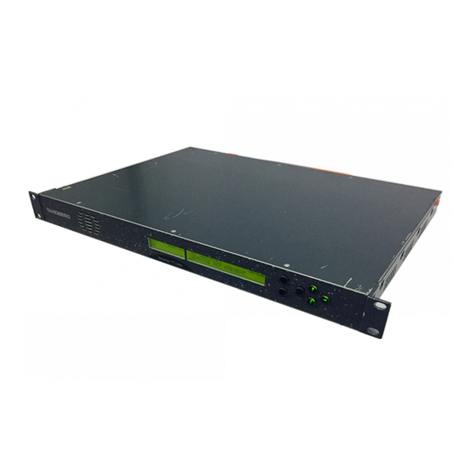
TANDBERG
TANDBERG TT1260 User manual
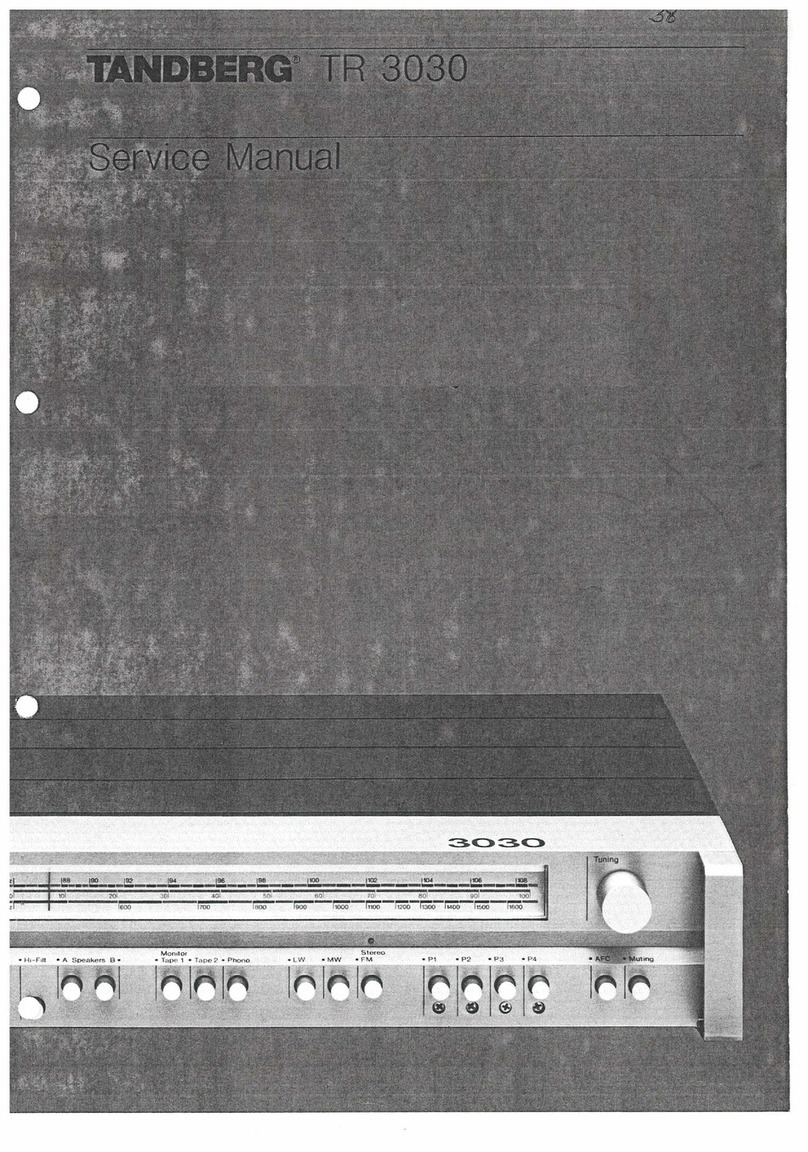
TANDBERG
TANDBERG TR 3030 User manual

TANDBERG
TANDBERG TT1220 Series User manual
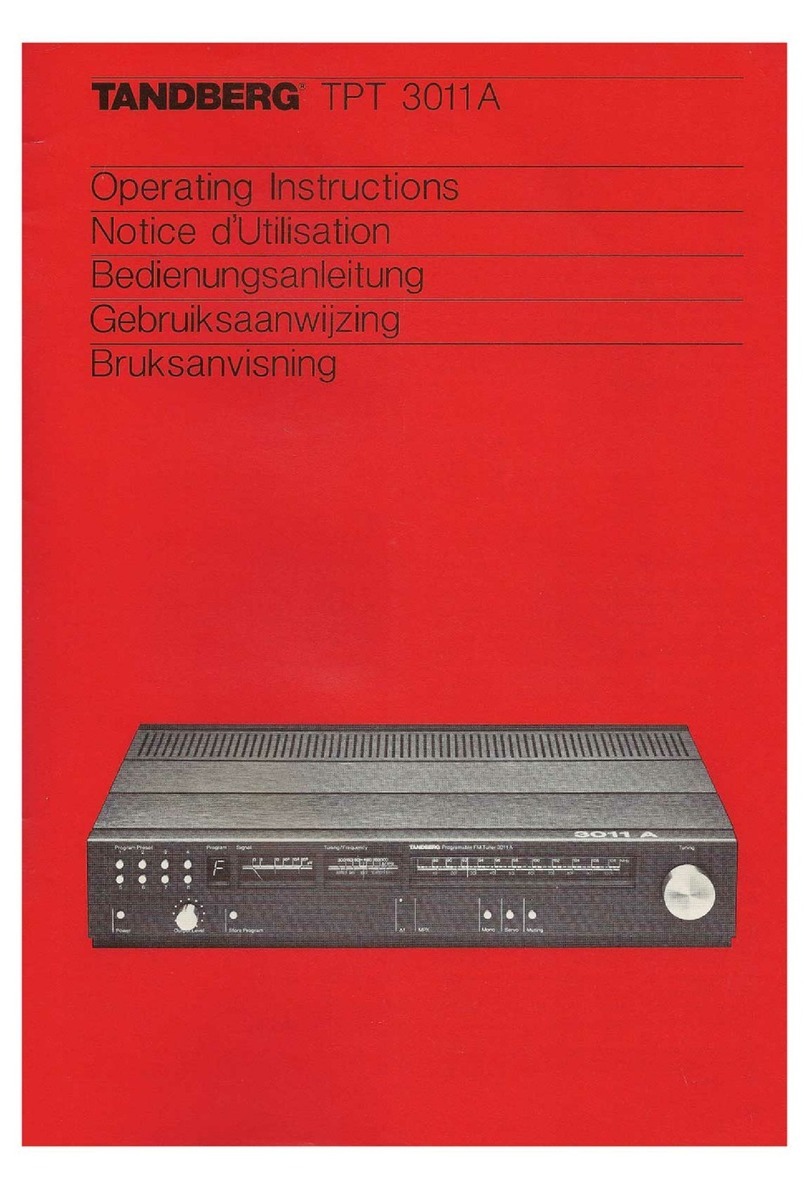
TANDBERG
TANDBERG TPT 3011A User manual
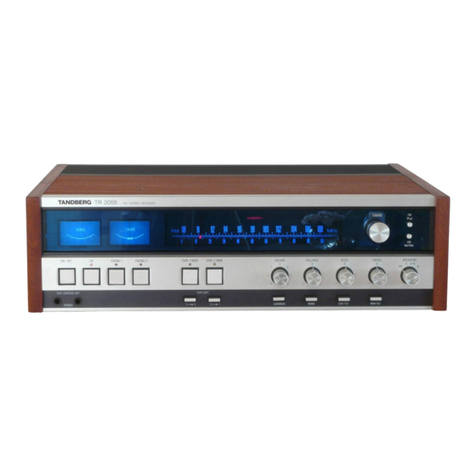
TANDBERG
TANDBERG TR 2055 User manual
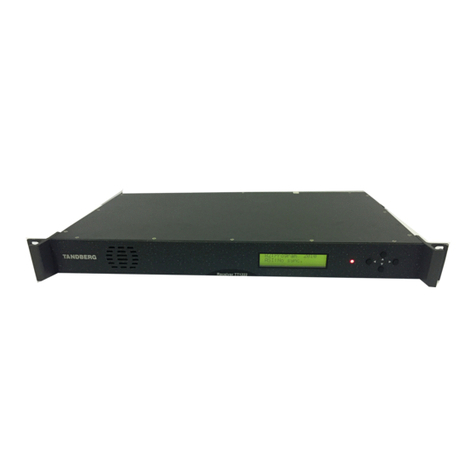
TANDBERG
TANDBERG TT-1222 User manual

TANDBERG
TANDBERG TT1260 User manual
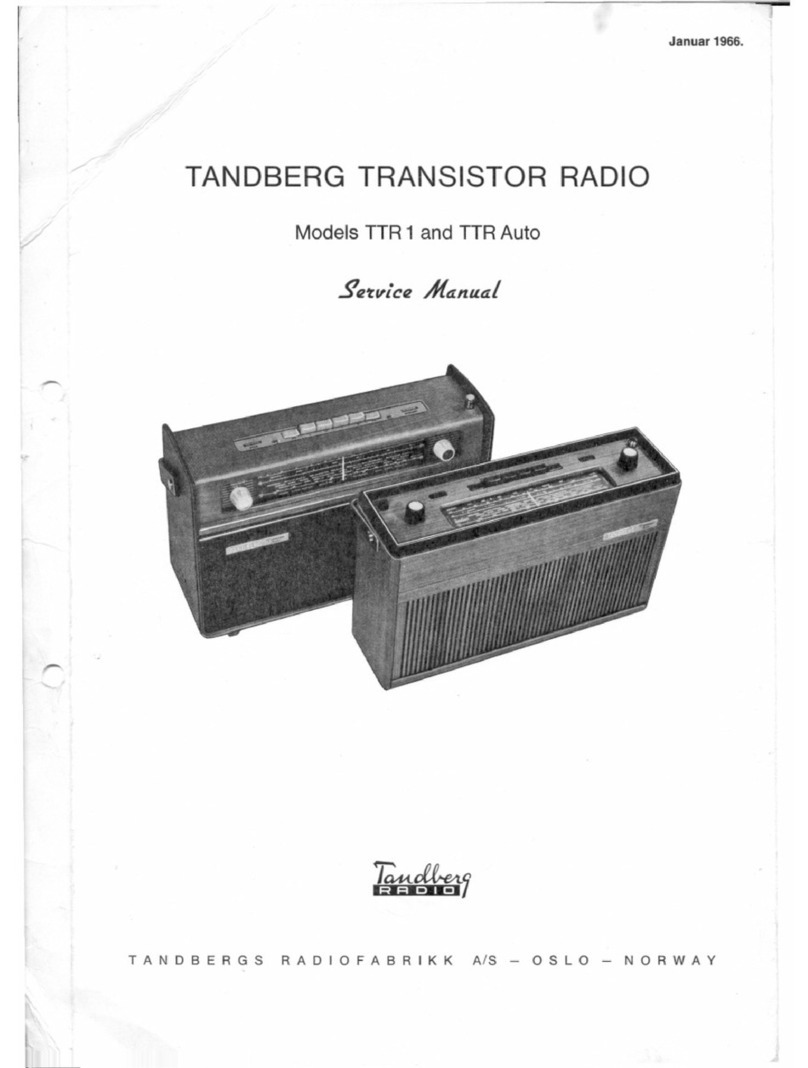
TANDBERG
TANDBERG TTR1 User manual
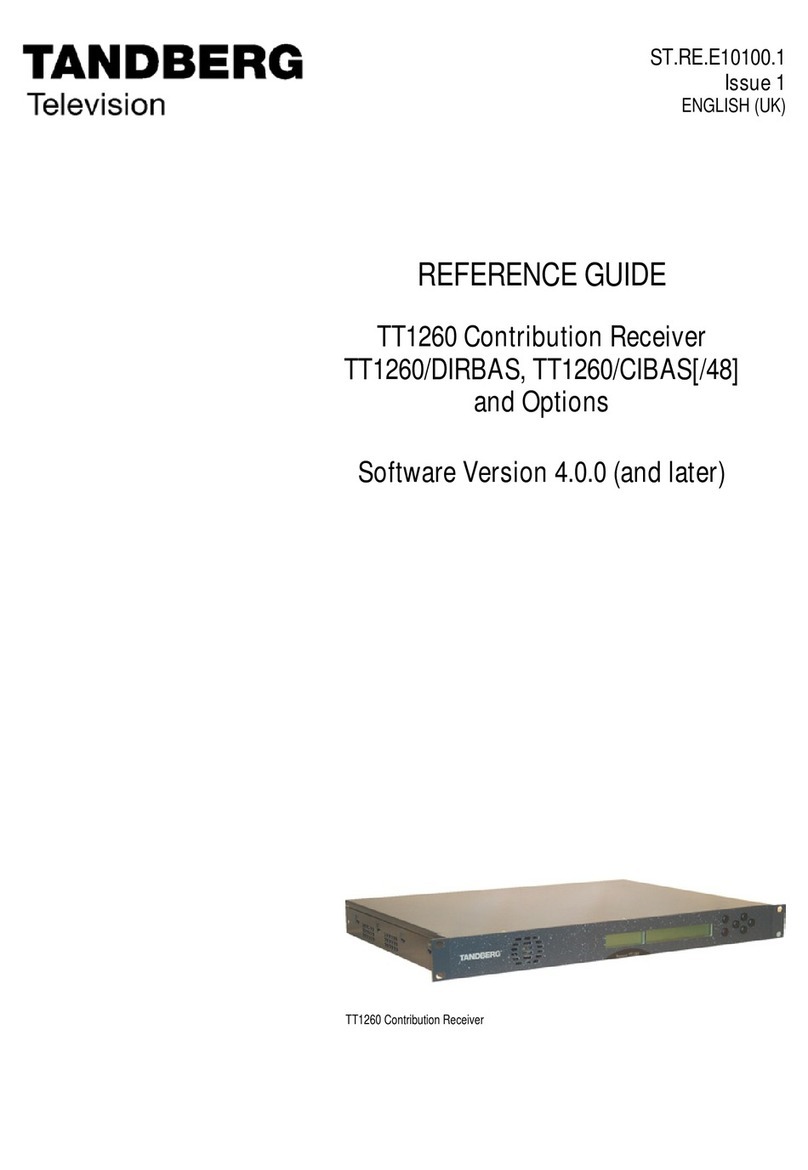
TANDBERG
TANDBERG TT1260 User manual
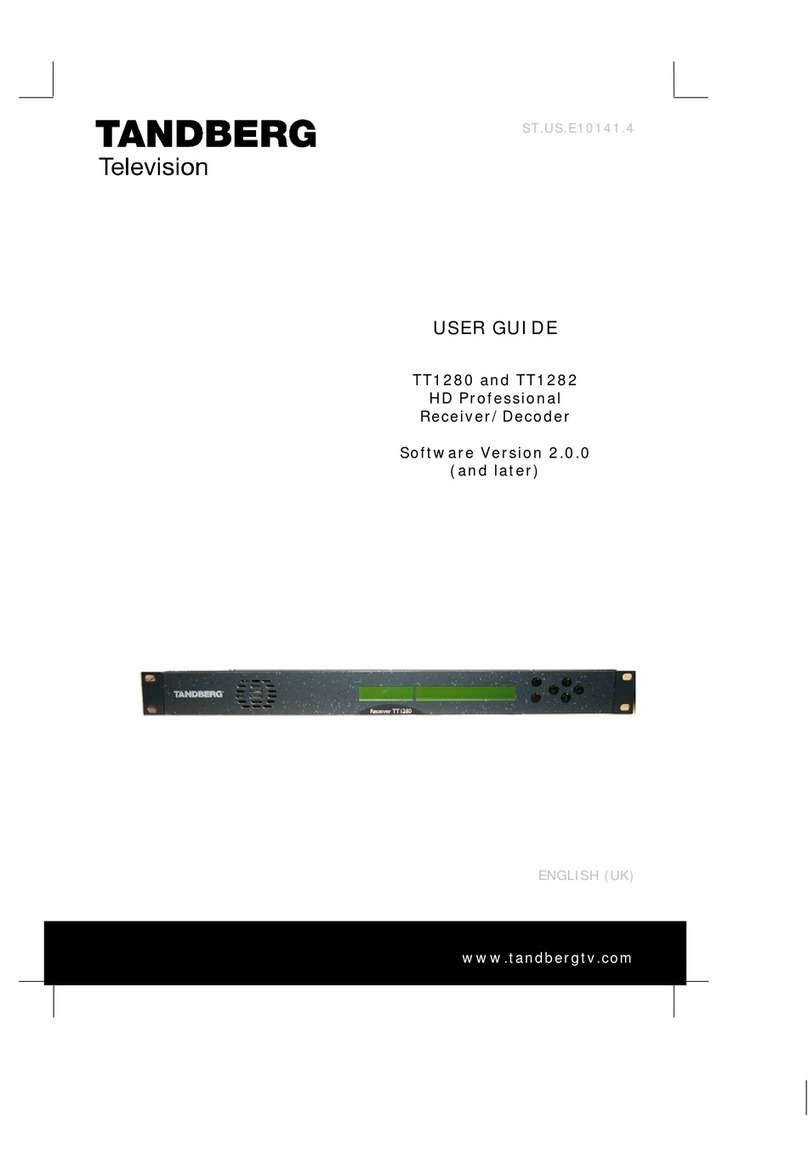
TANDBERG
TANDBERG TT1282 User manual
